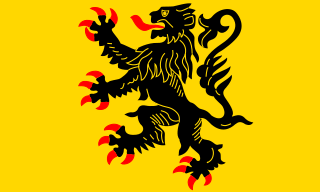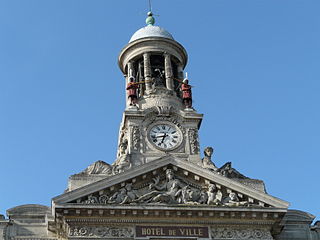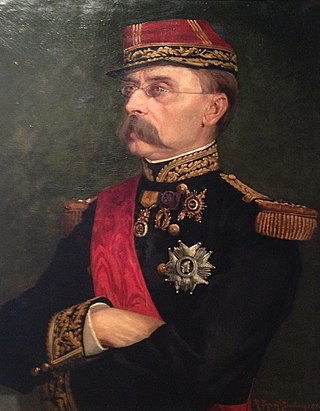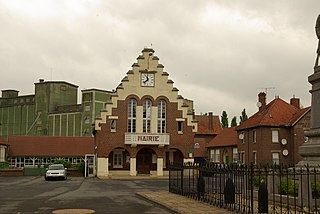
Nord-Pas-de-Calais ; Picard: Nord-Pas-Calés; West Flemish: Nôord-Nauw van Kales); is a former administrative region of France. Since 1 January 2016, it has been part of the new region Hauts-de-France. It consisted of the departments of Nord and Pas-de-Calais. Nord-Pas-de-Calais borders the English Channel (west), the North Sea (northwest), Belgium and Picardy (south). Until the 17th century, the history of the North was largely in common with the history of Belgium, that of a land that "for almost a thousand years served as a battlefield for all of Europe." The majority of the region was once part of the historical Southern Netherlands, but gradually became part of France between 1477 and 1678, particularly during the reign of king Louis XIV. The historical French provinces that preceded Nord-Pas-de-Calais are Artois, French Flanders, French Hainaut and (partially) Picardy. These provincial designations are still frequently used by the inhabitants. The former administrative region was created in 1956 under the name "Nord" and maintained that name until 1972 when "Pas-de-Calais" was added. This remained unchanged until its dissolution in 2016.

Cambrai, formerly Cambray and historically in English Camerick or Camericke, is a city in the Nord department and in the Hauts-de-France region of France on the Scheldt river, which is known locally as the Escaut river.

Valenciennes is a commune in the Nord department, Hauts-de-France, France.

Louis Léon César Faidherbe was a French general and colonial administrator. He created the Senegalese Tirailleurs when he was governor of Senegal.

The Viromanduī or Veromanduī were a Belgic tribe dwelling in the modern Vermandois region (Picardy) during the Iron Age and Roman periods. During the Gallic Wars, they belonged to the Belgic coalition of 57 BC against Caesar.

Caudry is a commune in the Nord department in northern France. Its inhabitants are called the 'Caudrésiens'. The town is mostly known as the Capital City of French Lace. Caudry station has rail connections to Douai, Cambrai, Paris, Lille and Saint-Quentin.

The Polytechnic University of Hauts-de-France, previously known as University of Valenciennes and Hainaut-Cambrésis until 1 January 2018, is a French public university, based in Valenciennes. It is under the Academy of Lille and is a member of the European Doctoral College Lille-Nord-Pas de Calais and of the Community of Universities and Institutions (COMUE) Lille Nord de France.

The Military Administration in Belgium and Northern France was an interim occupation authority established during the Second World War by Nazi Germany that included present-day Belgium and the French departments of Nord and Pas-de-Calais. The administration was also responsible for governing the zone interdite, a narrow strip of territory running along the French northern and eastern borders. It remained in existence until July 1944. Plans to transfer Belgium from the military administration to a civilian administration were promoted by the SS, and Hitler had been ready to do so until Autumn 1942, when he put off the plans for what was intended to be temporary but ended up being permanent until the end of German occupation. The SS had suggested either Josef Terboven or Ernst Kaltenbrunner as the Reich Commissioner of the civilian administration.

Vendhuile is a commune in the Aisne department in Hauts-de-France in northern France. It received the Croix de guerre for its suffering in World War I.

Saint-Python is a commune in the Nord department in northern France. It was named after Piatus of Tournai. Its inhabitants are called Saint-Piatiens or Piatonnais.
Augusta Viromanduorum is an ancient Gallo-Roman settlement, corresponding to the modern city of Saint-Quentin.
The University of Lille Doctoral College, formerly the European Doctoral College Lille Nord-de-France, is part of the University of Lille since the dissolution of the Community of Universities and Institutions Lille Nord de France in 2019.

The Community of Universities and Institutions (COMUE) Lille Nord de France was a French Groups of Universities and Institutions (COMUE) spread over multiple campuses and centered in Lille. It included a European Doctoral College and federated universities, engineering schools and research centers. With more than one hundred thousand students, it was one of the largest university federations in France. The University of Lille, with nearly 70,000 students, was its main component. The COMUE stopped its activity in 2019 and its activities were transferred to its founding institutions.

Hauts-de-France is the northernmost region of France, created by the territorial reform of French regions in 2014, from a merger of Nord-Pas-de-Calais and Picardy. Its prefecture is Lille. The new region came into existence on 1 January 2016, after regional elections in December 2015. The Conseil d'État approved Hauts-de-France as the name of the region on 28 September 2016, effective the following 30 September.

The Lamour Watermill is a museum and arts centre located in Briastre, Hauts-de-France, France. The water-powered mill and its edifices were built in the year 1800. It was originally used for milling grain, but stopped its operations in the 1930s before being converted into a museum by the Belleval family in the late 1990s.
Safilin is a French company specializing in linen and hemp spinning. Founded in 1778 in Armentières (Hauts-de-France), the company did not take its current name of Safilin until 1986. Headquartered in Sailly-sur-la-Lys, the company has relocated its production in Poland.

Occurring amid the Battle of France, the Oignies and Courrières massacre involved mass killings of French civilians in the two nearby town of Oignies and Courrières in Nord-Pas de Calais on 27–28 May 1940. The number of victims is reckoned at between 114 or 124. The unit responsible for the atrocity was the 487th Infantry Regiment of the 267th Infantry Division in the Wehrmacht. The massacre was one of the largest to occur during the Battle of France. Altogether, it is thought a total of 500 French civilians were murdered by German forces in Nord-Pas de Calais in May 1940.

The Departmental Council of Nord is the deliberative assembly of the French department of the Nord, the most populous French department. The headquarters of this decentralized local authority are in Lille.

The Nord-Pas-de-Calais cuisine is a French regional cuisine, whose specialties are largely inherited from the county of Flanders. The region has always been at an intersection of Europe, and traces of its history can be found in its specialties, such as the English influence on the Côte d'Opale, or dishes of Polish origin in the mining basin.
The culture of Nord-Pas-de-Calais is a component of French culture where multiple influences intertwine. The region has always been a crossroads of Europe, experiencing a great mix of population due to the various wars it has endured and the immigration it has attracted.

























